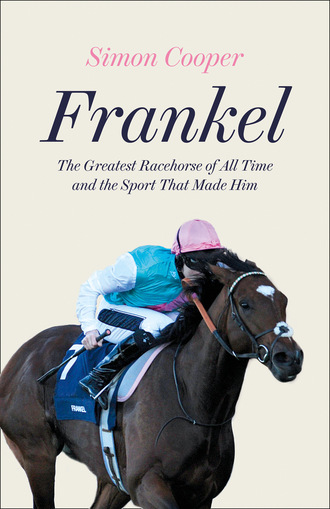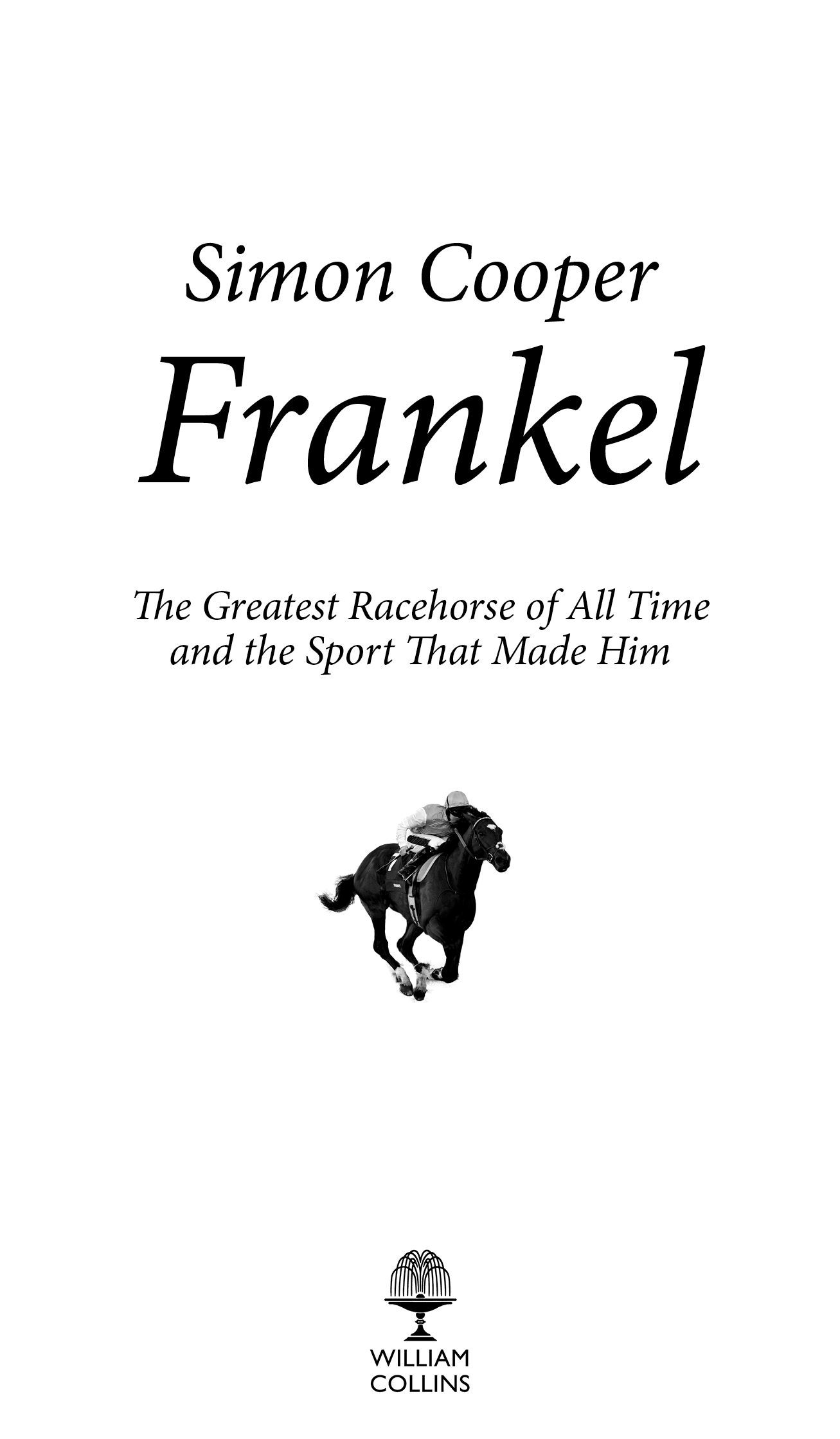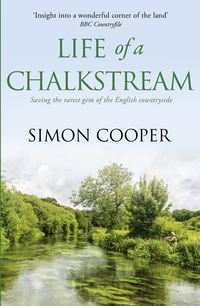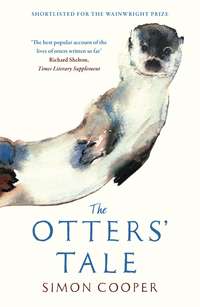
Полная версия
Frankel


Copyright
William Collins
An imprint of HarperCollinsPublishers
1 London Bridge Street
London SE1 9GF
WilliamCollinsBooks.com
This eBook first published in Great Britain by William Collins in 2020
Copyright © Simon Cooper 2020
Images © individual copyright holders
Race card © Racing Post
Cover image © CARL COURT/Stringer/Getty Images
Simon Cooper asserts the moral right to be identified as the author of this work
A catalogue record for this book is available from the British Library
All rights reserved under International and Pan-American Copyright Conventions. By payment of the required fees, you have been granted the non-exclusive, non-transferable right to access and read the text of this e-book on-screen. No part of this text may be reproduced, transmitted, down-loaded, decompiled, reverse engineered, or stored in or introduced into any information storage and retrieval system, in any form or by any means, whether electronic or mechanical, now known or hereinafter invented, without the express written permission of HarperCollins.
Source ISBN: 9780008307035
Ebook Edition © August 2020 ISBN: 9780008307059
Version: 2020-06-02
Dedication
Mum
Sorry I didn’t finish in time.
Epigraph
‘And Allah took a handful of southerly wind,
blew His breath over it, and created the horse.’
Bedouin legend
Contents
1 Cover
2 Title Page
3 Copyright
4 Dedication
5 Epigraph
6 Contents
7 Prologue
8 1 Genetic alchemy
9 2 A certain kindness
10 3 Creation day
11 4 Day 343
12 5 More Irish than English
13 6 The Pick
14 7 In training for training
15 8 A horse by a very special name
16 9 Warren Place
17 10 Getting into his head
18 11 The 6.35 at Newmarket
19 12 Intensive training
20 13 Economical with the actualité
21 14 Winter dreaming
22 15 Leading from the front
23 16 Arise Sir Henry
24 17 Duel on the Downs
25 18 The high-stakes gamble
26 19 Hidden dips
27 20 Flying the standard
28 21 Always summer
29 22 The end of days
30 Epilogue
31 The Newmarket 11
32 Keeneland to fenland
33 A six-figure loss
34 Last man standing
35 The worst Derby runner ever?
36 Up in the air
37 A 99 per cent write-down
38 The cruellest cut
39 All-weather man
40 Pinhooked
41 Scandal
42 Shadow man
43 Acknowledgements
44 The Frankel File
45 Pedigree
46 Race record
47 Timeline
48 Awards
49 Frankel by numbers
50 Picture Section
51 Bibliography
52 Index
53 About the Author
54 About the Publisher
LandmarksCoverFrontmatterStart of ContentBackmatter
List of Pagesiiiivvviixixiixiiixiv12345678910111213141516171819202122232425262728293031333435363738394041424344454647484950515253545556575859616263646566676869707172737475777879808182838485868789909192939495969799100101102103104105106107108109111112113114115116117118119120121122123124125126127128129130131132133134135136137138139140141142143144145146147148149151152153154155156157158159160161162163164165167168169170171172173175176177178179180181182183184185186187188189190191192193194195196197198199201202203204205206207209210211212213214215217218219220221222223225226227228229230231232233234235236237238239240241242243244245246247248249250251252253254255256257258259260261263264265267268269270271272273274275276277278279280281282283284285286287288289290291292293294295296297298299300301302303304305306307308309310311312313314315316317318319320321322323324325326327328329330331333338334339340341342343344345346347348349350351352353354
Prologue
In horse racing, greatness is defined by speed. Being the second fastest counts for little. You have to win. And win. And keep on winning until every challenger of your generation is put to the sword. Such a thing so rarely happens that most people pass through life without the privilege of seeing such an animal. Occasionally a contender will arrive, burning up the turf until the dream of greatness is shattered in defeat; that precious cloak of invincibility torn to shreds by another.
On a rainy Suffolk evening, did our locally trained bay colt have any idea that he was about to embark on that path to the ultimate in racing greatness? To become the one against which all horses of the past, present and future would be judged and likely fall short. Let’s face it, he probably didn’t.
In truth, despite the remote possibility of such a thing, he had a whisper of a chance; he was bred if not to be great then at least to be fast. But that counts for only so much. Hundreds of thoroughbred racehorses debut each season with bloodlines as good as our horse. But breeding will only take you so far; the rest lies deep within, far beyond human intervention.
If you’d been a casual observer among the thousands gathered at Newmarket races on 13 August 2010, the third race of the night didn’t promise very much. In fact, it was a meeting far removed from the highest rank, designed more to draw a big holiday crowd than for quality racing. It was one of those humdrum, unregarded workaday fixtures which are the bread and butter of horse racing around the globe – excepting one horse.
You probably didn’t bother to go to the paddock after the second race to watch the horses parade for the next; few did. What was meant to be a balmy summer evening had turned cold with squally-soon-to-become-heavy rain. Trainers, jockeys, stable hands and officials were all scurrying around truncating the preliminaries to the shortest possible duration. The lawns in front of the stands were pretty well deserted; the crowds were jammed inside. A few hardy types sheltered under umbrellas to be close to the horses, but in truth they were few and far between. After all, this was just a minor race with a dozen horses, eight of which had never raced before and the remaining four had hardly set the world alight, without a win between them.
For our horse, this was to be his racecourse debut; he was one of that eight. But was he the special one? Maybe. There was a buzz about him. He’d lit up the training gallops. Been the gossip of this racing town. He’d been named in honour of one of the greatest trainers of modern times. Expectations were high. A sick man, his trainer, was being rejuvenated just by his very being. But this was a wretched night; his stable hand had even lost his shoe in the quagmire leading up to the start. If it all went wrong, there were at least excuses to hand.
By the time you’d extracted yourself from the bar, placed a bet and found a vantage point in the stands, the horses would have been long gone, gathered at the start a mile away. Without high-powered binoculars they would have been nothing more than a wet smudge on the otherwise empty horizon of Newmarket Heath that doubles as a racecourse. With binoculars you’d have seen jockeys hating the rain, crouched over their horses, keeping them calm with a circling routine. Had you been at the start, you would have heard the starter’s assistant complete the roll call as the handlers stepped forward to lead each horse in turn into the designated compartment of the starting stalls. A moment later, the loading complete, the gates of the stalls would spring open. The race was on.
Did our horse lead from pillar to post, leaving all others struggling in his wake, the rain-sodden crowd gasping in awe at his performance? I’d like to tell you yes, but it wasn’t really that way. In a race that lasts less than two minutes – this was just a mile – a quick getaway helps. But our young blood blew it. Months of training counted for nothing as this critical moment vanished in a trice. He was closer to last than first with half the race run. Had you placed a bet on him – he was the favourite, after all – you might have had reason to worry. But really you need not have done. Our horse was a cut above the rest. He knew it. And you, too, would know it soon.
He had been trained to run this way. He was headstrong. A horse who knew his mind but was prone to run too fast, too soon. His trainer, the best of the best, saw this in him so taught him the value of patience. The waiting game. Cruising behind the others until the moment was right. And that is how this race has become a part of horse-racing history.
In the wet gloom, as the track rose towards the finishing line, the jockey eased our horse out from behind the pack to make his run. There was nothing hurried. Really, there was nothing to doubt. He drew level with the leaders, kept time with them for a few strides as if to make some point before pulling away with ease as the winning post flashed by. Whether you were a seasoned racing professional or a once-a-year punter, our horse would have caught the eye. ‘Impressive’, you’d have said. ‘Very impressive.’ And you’d have logged the name of our horse in that part of your brain reserved for something out of the ordinary.
One hundred and three seconds on from the start, the horse drawn in stall ten had passed the winning post ahead of the rest. That was to become something of a habit as Frankel was now, despite the apparent inauspiciousness of the occasion, on his way to becoming the greatest racehorse to ever live.

1
Genetic alchemy
Yesterday I met Frankel who crept up on me all of a sudden. One moment I was deep in conversation and the next I sensed a presence behind me. Maybe someone said something along the lines of ‘here’s the man’. In truth, I don’t recall precisely but when I turned around there he was: the greatest racehorse that has ever strode out on God’s turf.
As I wended my way across the Cambridge fens, which in turn gave way to the ordered horse paddocks that surround Newmarket, I tried not to elevate this meeting to something of a semi-religious experience. An audience with the Pope. A pilgrimage to a Tibetan mountaintop to meet the Dalai Lama. It seemed the wrong side of sane to equate a horse on such a level.
And indeed that is true. But rarely in life does one ever get to meet the truly great. They are the stuff of legends. Stories passed down through generations. The prism of time only giving us a hint of what the truth may have been. But here was I doing that very thing. A chance to look, see and touch. Make a judgement all of my own. To burn into my memory a horse that will likely never, ever exist again.
You’d barely give Frankel’s home a second glance if you drove past. Yes, the sweeping turn to the entrance looks immaculate, but the redbrick walls are low and the signs discreet. Beyond the gates that swing open to acknowledge your arrival, the scene that greets you appears to be anything other than a horse stud farm.
The smooth tarmac gives way to immaculately raked gravel that scrunches under my tyres. In the absence of signs, a kindly gardener points me in the right direction, curving me around the tall copper beech that was hiding the offices. Well, these are not offices in the absolute sense of the word, but rather the most magnificent country house, known as Banstead Manor Stud, that people just happen to work in. It is the European headquarters of the world-famous racing and breeding operation, Juddmonte, owned by His Highness Prince Khalid bin Abdullah bin Abdulrahman Al Saud, known universally across racing as Mr Khalid Abdullah, befitting his privacy and pursuit of excellence. I honestly don’t know if Juddmonte’s Banstead Manor was designed by the British architect Sir Edwin Lutyens, but it has all the heritage. Long, horizontal, thin red bricks delineated by perfectly trowelled lime mortar. Tall, slender chimneys, artworks in their own right. Narrow windows that mimic the first Elizabethan age. I’m ushered into a rather grand room which is full of Frankel memorabilia; even the mints are wrapped in his racing colours. Among the paintings and prints is a faded handwritten letter from a son to his mother in old-fashioned copperplate script. It seems Frankel is not the only one to achieve world fame to have lived at Banstead Manor; this was the childhood home of Winston Churchill.
I’m met by Shane Horan who is introduced to me with a job title I’ve never heard spoken of before, but that speaks more to my ignorance in these matters than the title itself: Nominations Manager. He is, it transpires, responsible for which mares are chosen each season (requests to mate with Frankel are significantly oversubscribed). We sit down in what I guess would once have been the drawing room, with furniture as comfortable today as it would have been back when this was a grand home. Reclining on the sofa, I have a glorious view across a York stone terrace, striped lawns, and between the house and yet another copper beech, a statue of a full-sized horse on a Portland stone plinth. I hazard a guess that it might just be Frankel. I am correct.
I pull out my pad and start to ask Shane a few questions, but we both know that really I am being polite. Seeing Frankel is the thing. The answers will come later. We are just playing for time. Soon Shane looks at his watch, stands up, and beckons me to follow. ‘We’ll just catch him on the way back.’ It is shortly before 3 pm but I’m none the wiser as to where Frankel has been or where he is going. I don’t like to ask, as the assumption seems to be that I should know.
My other assumption was that I’ll need a pair of wellington boots to tramp around, or at least make my way to the stud yard. Shane gives me a quizzical look when I ask whether I should change footwear. I’ll take that as a no. The walk to the stables is both short and perfection. Another striped lawn gently slopes away from the house. A small lake gurgles as a pulsing fountain spouts water. The yew hedges are geometrically precise. Gertrude Jekyll, Lutyens’ landscape gardener of choice, would most definitely have approved of the splendid herbaceous borders, the flock of colours rising from low at the front to tall at the back. Less than a hundred yards from the house, Shane swings open a small gate and beyond the shiny, black-painted tubular steel of the estate fencing is more striped lawn, specimen trees, soft pale shingle pathways and three turreted stable blocks.
Disabuse yourself that this is any ordinary stable block; if there was a star rating for horse accommodation this would be seven star plus a bit more. The original building, that houses just two horses, repeats the brickwork of the house, with dark-wood stained stable doors at either side adorned with solid brass catches and bolts. In the centre a corbelled arch leads to a white-painted door, slightly knocked and careworn by daily stud life, with the tack and feed store beyond. The slate roof is topped by two jaunty looking turrets, which serve as ventilation shafts, each of which is capped by what you might easily mistake for a black pointed witch’s hat. The shafts, a sort of forerunner to air conditioning, were by all accounts originally installed by army engineers who were billeted in the stables during World War II, and the style has been replicated with the three later stable blocks, perfect facsimiles both, with housing for eight stallions in total. This is, and has been for the past six years, Frankel’s home.
There is most definitely a sense of theatre leading up to meeting the equine who is often termed, with no sense of anything other than the truth, the wonder horse. In turn, I am shown stallions Bated Breath, Kingman and Oasis Dream who are led out of their respective stalls for my perusal. Privileged though I am to see them, I do feel a bit of a fraud. If you are a keen follower of horse racing, and breeding in particular, those names will leap from the page. For me, just starting my equine genetic education, they are simply the most beautiful specimens in the prime of life, living in the most splendid surroundings. In time I’ll piece it all together, but for now, without wishing to diminish them in any way, they are the amuse-bouche.
As I turned to see Frankel for the first time, he was most definitely different to the others but perhaps not quite as I imagined. While the first three had variously danced on their toes, squiggled their ears, held heads high, eyes darting to every person and chewing on the brass chain that connects leading rein to head collar, along came Frankel, head bowed down. There was no fuss. No ceremony. I would say he sauntered up to me, but that suggests a levity of demeanour which is not him at all. He moved with considered purpose. Each stride was for a reason, delivering one foot in front of the other with an economy of effort. Pausing at the required spot as if to say, I’m not going to move further unless it is absolutely necessary. But don’t mistake this for laziness. Here was a horse who was alert to everything and everybody around him.
He took to my scratching at the white star on his forehead in good part. Just patting him on the neck seemed rather inadequate; too small and fleeting a gesture to connect with this great beast. He kept his head slightly bowed as we went eye-to-eye. I slid my hand down the front of his face, tracing the line of his blaze, the white hairs that narrow then widen again just as the coat gives way to the soft, dark skin of the muzzle. Warm breath gently exhaled from his nostrils, the steady beat of breathing pacing out the comfortable moments between us. There was a slight damp odour in the air, but not unpleasant. Oats and hay maybe? As I jiggled my fingers around his wet mouth, we ended up playing a little game as he twisted his lips as if to capture a stray piece of my hand. Until, quite suddenly, without breaking eye contact, he nudged my hand away. The game was over.
For Rob Bowley, his stallion man, had just produced the most enormous carrot. However potentially tasty my fingers might have been, carrots were clearly a known quantity in Frankel’s life. It is fair to say, he was not a tidy eater. As he bit, crunched and chewed his way through this industrial-sized vegetable, a pool of carrot juice and orange-coloured pulp, certainly enough to fulfil one of your five-a-day, gathered at his feet. So intent on eating, he didn’t seem to notice the brief arrival of the stud cat George who sidled over to sniff, then reject, a possible windfall. That said, George and Frankel go back a long while, as the cat arrived at Banstead just a month before the horse, though the pedigree of the latter was considerably more certain than that of the former. George just appeared from nowhere, the grey tabby taking up residence without so much as a by-your-leave. Despite much asking around the village nobody ever claimed him so, as the Frankel express has thrilled ever faster, George had been along for the ride, elbowing his way into photoshoots and among film crews. I’m not sure Frankel liked sharing the limelight, for he studiously ignored George, as all the while I stood at his head he kept me fixed in his gaze, those dark brown eyes giving nothing away.
And that is what I recall most about my first meeting with Frankel. Not his impressive frame. Not his beautiful home. But his eyes. They followed the unknown quantity, in this case me, everywhere. Rob, Shane and all the other Banstead people – Frankel had locked them away deep inside that head of his. But of the new, he was curious. Something to be sized up, evaluated and considered. As Frankel was wheeled away and he gave me one last sidelong glance, it was hard not to come to the conclusion that he had been judging me more than I had been judging him. It was an odd and slightly perplexing sensation. He is, after all, only a horse but I felt I had undergone some sort of benediction.
Once Frankel was gone everyone definitely relaxed – now that is odd – as the conversation turned to his daily regime. The question in my mind was soon answered without me ever having to ask it – Frankel was on the way back from his 3 pm covering. Or to put it in layman’s terms, a mating with one of the 150 or so mares that would be visiting with him from mid-February (breeders with some sense of humour commence the season the day after St Valentine’s Day) until mid-June. If you are starting to do the maths to conclude that is a lot of covers in not a lot of time, you’d be right. Plus you have to account for some multiple covers of the same mare to ensure success. So, at the moment of my mid-afternoon meeting, Frankel was only just past the halfway point in his day with 7 am, 3 pm and 9 pm appointments in his daily diary. Great genes are in great demand.
Today Frankel is ten and has spent the greater part of his adult life at Banstead Manor Stud in Suffolk. Indeed, this was where he was born, but his story really starts 400 miles due west in another horse county of another horse country. County Tipperary in Ireland.
There is a fine motorway that takes you from Cork in the direction of Dublin. It’s very twenty-first century with wide lanes and tolls; maybe it is the latter that discourages traffic because it seemed very empty to me. But the moment you turn off to follow the signs to Fethard, you are in old Ireland. The lanes are narrow. The stone walls in need of repair. Topped with hedges interspersed with ragged barbed-wire fencing. You would never call the rural architecture that plots your journey beautiful. The grey, squat, rectangular bungalows are built with practicality rather than beauty in mind, often juxtaposed by the adjacent farmyards that seem to have been forever falling down awaiting a wave of gentrification that may never arrive.
And pretty soon you are in Fethard. The roads are potholed. Shops are boarded up. This seems like a bit of Ireland still awaiting the arrival of the Celtic tiger. But you can’t help but smile at the sign on the wall outside the bar: McCarthy’s est. 1840. Publican. Restaurant. Undertaker. One of Ireland’s oldest unchanged pubs. If that doesn’t arrest the progress of a hungry traveller nothing will, though the slight carbolic smell that hangs over the town is disconcerting. Here is a place where peat is still burned as the fuel of choice.
On, through and out the other side of Fethard and suddenly twenty-first-century Ireland seems to be back, but with a twist of rural chic. Instead of just driving down a road you appear to be driving down an avenue. The verges are trimmed. The hedges cut box-straight, lined on the field side with gradually maturing trees planted perfectly parallel to the road, and beyond that post and rail fences delineating paddocks. Even the farm gates are a cut above your usual rural offering, with sweeping turn-ins and fancy stone pillars. Helpful signs direct you off the road to such-and-such farm or so-and-so stud. Occasionally, you catch a glimpse of a group of mares and their foals.





